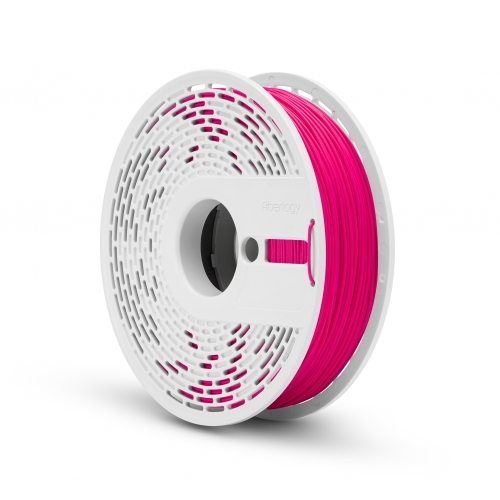
Fiberlogy FiberFlex 40D Pink 1.75 mm 850 g
F40-PINK-175-085
Brand: Fiberlogy, Poland
Fiberlogy FiberFlex 40D is a high-quality flexible filament with Shore 40D hardness, providing an optimal balance between elasticity and strength for creating flexible functional products.
- Strength: Medium-high | Flexibility: High
- Printing Difficulty: Medium (easier than most flexible materials)
- Printing Temperature: 200°C - 220°C
- Bed Temperature: 50°C - 70°C
- High impact resistance at low temperatures
- Excellent thermal and chemical resistance
- Increased printing speed (up to 45 mm/s)
- NET weight: 850 g
Description of Fiberlogy FiberFlex 40D Filament for 3D Printers
3D For You offers you the opportunity to purchase Fiberlogy FiberFlex 40D filament with 1.75 mm diameter and 850 g weight to experience the unique capabilities of 3D printing with flexible materials.
Fast and precise? Yes, it's possible. FiberFlex 40D is the best proof of this. With this flexible filament with Shore hardness of 40D, you can print at a speed of 45 mm/s without worrying about the quality of the print. What's more, thanks to FiberFlex 40D, you will discover that flexible 3D printing doesn't have to be difficult. Feeding it to the extruder will be extremely easy, and the printed layers will stick together well.
Your 3D prints will have properties such as high impact resistance, low temperature resistance, chemical and abrasion resistance. Because of these qualities, FiberFlex 40D can be used for both amateur and professional applications. This flexible filament also gives you a variety of colors and helps you find the best one for any project.
If you are interested in other flexible filaments, you should take a look at our other materials. For example, Fiberlogy FiberFlex 30D is another material similar to TPU filaments. It is a softer version of FiberFlex 40D. On the other hand, Fiberlogy MattFlex 40D is a matte flexible filament that offers a non-gloss finish.

3D4U is the official distributor of the Polish brand Fiberlogy in Ukraine.
Our offer includes a wide range of filament for 3D printing. We provide professional consultation and guarantee that all Fiberlogy products presented are original.
Properties of Fiberlogy FiberFlex 40D Filament
Fiberlogy FiberFlex 40D filament stands out among other flexible materials for 3D printing thanks to its unique characteristics that make it indispensable for creating elastic and flexible products with improved mechanical properties.
- Shore 40D hardness - provides an optimal balance between flexibility and strength
- High impact resistance at low temperatures - products maintain elasticity even in cold conditions
- Excellent thermal, chemical, and abrasion resistance - increases the durability of finished products
- High printing speed - allows printing at speeds up to 45 mm/s, which is significantly higher than most flexible materials
- Stable feeding - filament feeds easily into the extruder, minimizing the risk of jamming or uneven extrusion
Important: Although FiberFlex 40D is easier to print with than many other flexible materials, for best results it is still recommended to use a direct drive extruder and the correct temperature settings.
Applications of FiberFlex 40D
Thanks to its increased hardness and good balance between flexibility and strength, Fiberlogy FiberFlex 40D is ideal for a wide range of applications:
- Rubber elements for mechanisms: gaskets, seals, parts that are frequently bent
- Gadgets and their components: phone cases, watchbands, heart rate monitors, pedometer straps
- Connecting elements: flexible hinges, dampers, adapters
- Toys and their components: tires, rubber figures, flexible components
- Jewelry: bracelets, elastic elements for accessories
- Functional prototypes: parts requiring a combination of flexibility and strength
- Protective cases: shock-absorbing elements for electronics and fragile devices
FiberFlex 40D is especially valuable for projects that require higher strength and wear resistance than softer FiberFlex 30D can offer, while still maintaining the necessary flexibility and elasticity.
Printing Parameters for Fiberlogy FiberFlex 40D
The following parameters are recommended print settings for this material. To ensure the best print quality, it is necessary to select appropriate settings for your specific printer and printing conditions.
| Parameter | Value |
|---|---|
| Nozzle Temperature | 200-220°C |
| Bed Temperature | 50-70°C |
| Closed Chamber | not required |
| Cooling Fan | 50-75% |
| Flow Rate | 105-110% |
| Print Speed | < 45 mm/s |
| Print Surface | glass, masking tape, 3DLAC |
| Retraction (direct extruder) | 1-2 mm |
| Retraction Speed | 10-30 mm/s |
| Drying Conditions | 60°C / 4h |
Note: Products made from flexible materials, including FiberFlex 40D, have high adhesion to the print surface. To facilitate model removal, you can heat the bed to 60-90°C after printing is complete — this often helps separate the model without damage. When printing on glass, in some cases it's more effective to wait for the surface to cool completely. Remove the model carefully to avoid deforming the flexible part.
Technical Specifications of FiberFlex 40D
| Parameter | Value | Test Method |
|---|---|---|
| Diameter | 1.75 mm ± 0.05 mm | - |
| Density | 1.16 g/cm³ | ISO 1183 |
| Shore A Hardness | 91 | ISO 7619 |
| Shore D Hardness | 40 | ISO 7619 |
| Tensile Strength | 28 MPa | ISO 527 |
| Elongation at Break | 700% | ISO 527 |
| Melting Temperature | 160°C | DSC |
| Heat Distortion Temperature | 70°C | ISO 75 |
Tips for 3D Printing with FiberFlex 40D
Although FiberFlex 40D is relatively easy to print for a flexible material, here are some tips to help you achieve the best results:
- Use a direct drive extruder - for the best control of filament feeding and minimizing jamming issues.
- Optimize print speed - while FiberFlex 40D can print at speeds up to 45 mm/s, for more complex models or better surface quality, it's recommended to reduce the speed to 30-35 mm/s.
- Set up proper retraction - flexible materials require less retraction, typically 1-2 mm for direct extruders. For Bowden systems, retraction may need to be disabled.
- Increase Flow Rate - usually to 105-110% for good filling and layer adhesion.
- Dry the filament before printing - flexible materials are hygroscopic; it's recommended to dry them at 60°C for 4 hours for best results.
- Use cooling fan with moderate intensity - 50-75% is usually the optimal value for cooling layers without compromising layer adhesion.
- Ensure good bed adhesion - use adhesives such as 3DLAC or masking tape for secure attachment of the first layer.
Tip: Even if you have experience printing with other flexible materials, it's recommended to print a small test model to calibrate settings before moving on to larger and more complex projects.
Comparison with Other Flexible Materials
The Fiberlogy flexible filament line presents various materials with different degrees of hardness and unique properties. The choice of a specific material depends on your project requirements.
| Material | Shore Hardness | Key Differences | When to Choose |
|---|---|---|---|
| FiberFlex 30D | 30D | Maximum flexibility, ultra-high elasticity | For the most flexible and elastic products that mimic rubber |
| FiberFlex 40D | 40D | Optimal balance of flexibility and strength, increased printing speed | For most projects requiring flexibility and durability |
| MattFlex 40D | 40D | Matte surface, same mechanical properties as FiberFlex 40D | For aesthetic flexible products with a matte finish |
| FiberFlex CF | 60D | Contains carbon fiber, increased strength | For high-strength flexible components requiring mechanical resistance |
| TPU | 55D | Standard thermoplastic polyurethane from other manufacturers | Alternative when medium flexibility is needed |
FiberFlex 40D occupies the sweet spot in Fiberlogy's range of flexible materials, offering higher strength than FiberFlex 30D while maintaining good flexibility. This makes it a versatile choice for a wide range of projects and an ideal starting material for those beginning to work with flexible filaments.
Why Choose Fiberlogy FiberFlex 40D
Fiberlogy FiberFlex 40D represents an optimal solution for creating flexible and elastic products thanks to several key advantages:
- Ease of use - one of the easiest flexible filaments to print on the market, ideal for beginners
- High printing speed - up to 45 mm/s, which is significantly faster than most other flexible materials
- Balance between flexibility and strength - Shore 40D hardness provides an optimal combination of elasticity and mechanical strength
- Excellent layer adhesion - creates strong and durable models without delamination
- Wear resistance - high abrasion resistance increases the service life of finished products
- Chemical resistance - resistance to a wide range of chemicals
- Versatility of application - suitable for both amateur and professional projects
By choosing Fiberlogy FiberFlex 40D from the official distributor 3D4U, you receive not only a high-quality material for 3D printing but also a guarantee of product authenticity, professional support, and fast delivery throughout Ukraine.
How to Order Fiberlogy FiberFlex 40D
Ordering Fiberlogy FiberFlex 40D in Ukraine is very simple through the 3D4U online store:
- Select the desired filament color from our catalog
- Add the product to your cart
- Proceed to checkout
- Confirm your order
If you have any questions about Fiberlogy products or the ordering process, our specialists are always ready to provide consultation by phone or email. We value every customer and strive to ensure the most comfortable process for purchasing and using 3D materials.
Start creating quality flexible products today with Fiberlogy FiberFlex 40D filament!
FAQ (Frequently Asked Questions) about Fiberlogy FiberFlex 40D
The main difference between FiberFlex 40D and FiberFlex 30D lies in their hardness on the Shore D scale:
- FiberFlex 40D has a hardness of 40 on the Shore D scale (91 on the Shore A scale), making it stronger and less elastic.
- FiberFlex 30D has a hardness of 30 on the Shore D scale (81 on the Shore A scale), making it softer and more elastic.
Due to its increased hardness, FiberFlex 40D is easier to print (allowing speeds up to 45 mm/s versus 35 mm/s for 30D), stretches less when deformed, has a higher tensile strength (28 MPa versus 22 MPa), and is better suited for functional parts requiring a balance between flexibility and strength. FiberFlex 30D, in turn, is better suited for projects that require maximum flexibility and elasticity, similar to soft rubber.
Yes, printing FiberFlex 40D on a printer with a Bowden extruder is possible and easier than with softer flexible materials such as FiberFlex 30D. However, to achieve the best results, consider these recommendations:
- Use the shortest possible path from the filament feed to the extruder
- Reduce print speed to 20-30 mm/s
- Use a high-quality PTFE tube with minimal internal diameter
- Minimize or completely disable retraction
- Ensure the filament cannot bend or compress in the tube
Despite these recommendations, you will still achieve the best results with flexible materials, including FiberFlex 40D, using a printer with a direct drive extruder.
Products printed from FiberFlex 40D have limited waterproofness, which depends on several factors:
- Infill density: Models with a high percentage of infill (90% or higher) will be more waterproof.
- Number of perimeters: Increasing the number of perimeters (4-6) significantly enhances waterproofness.
- Layer height: Thinner layers (0.1-0.15 mm) create a denser structure with fewer micropores.
- Post-processing: Some types of post-processing, such as impregnation with silicone sealants or application of special coatings, can make products completely waterproof.
For truly waterproof products, it is recommended to use 100% infill, maximum number of perimeters, and additional post-processing. It's worth noting that due to its chemical resistance, products made from FiberFlex 40D are well-suited for applications where contact with water is inevitable, even if absolute waterproofness is not required.
Products made from FiberFlex 40D are characterized by high durability and can maintain their mechanical properties for a long time under proper operating conditions:
- Mechanical properties: Under normal operating conditions (without extreme loads or environmental conditions), products can maintain their initial mechanical properties for years.
- UV resistance: Although the material has moderate resistance to UV radiation, prolonged exposure to direct sunlight may lead to fading and some reduction in mechanical properties.
- Temperature stability: Products maintain flexibility at temperatures from -30°C to +70°C, making them suitable for use in a wide range of conditions.
- Chemical resistance: The material is resistant to most household chemicals, which contributes to maintaining properties even when in contact with various liquids.
For maximum durability, it is recommended to avoid prolonged exposure to UV radiation, temperatures above 70°C, and strong oxidizers. Under these conditions, products made from FiberFlex 40D can last significantly longer than similar products made from many other materials for 3D printing.
Yes, products made from FiberFlex 40D can be painted, but due to the flexible nature of the material and its chemical resistance, special approaches are required:
- Acrylic paints with special modifiers for flexible surfaces - provide good adhesion and maintain flexibility
- Specialized paints for TPU and elastomers - specifically designed for flexible materials and have optimal adhesion
- Paints for vinyl and rubber - adhere well to flexible surfaces and maintain elasticity
- Spray paints with prior priming - for this method, a special flexible primer must first be applied
Before painting, it is recommended to:
- Thoroughly clean the surface from contaminants and degrease it
- Lightly sand the surface with very fine sandpaper for better adhesion
- Apply thin layers of paint, allowing each layer to completely dry
- If necessary, use a flexible varnish to protect the paint
It's important to remember that a thick layer of regular paint may crack when the flexible product is deformed, so choosing the right paint and application technique is crucial.
Although the base polymer used in FiberFlex 40D may itself be safe, standard Fiberlogy FiberFlex 40D filament for 3D printing does not have official certifications for food contact. There are several factors to consider:
- Lack of food certifications: The material has not undergone special tests and is not certified for food use
- Micropores in 3D printed products: Even with high quality printing, 3D printed products contain microscopic pores that can accumulate bacteria
- Additives and colorants: The filament may contain colorants and additives whose safety for food contact has not been confirmed
- Production process: The production of standard filaments does not follow protocols necessary for materials in contact with food
If you need to create products for food contact, it is recommended to:
- Use specialized food-grade filaments with appropriate certifications
- Consider applying a food-grade sealant to finished FiberFlex 40D products to create a barrier
- Use FiberFlex 40D products only for indirect short-term food contact
In any case, before using 3D printed products in contact with food, it is recommended to consult with relevant specialists.
You can determine if FiberFlex 40D filament has absorbed excessive moisture by the following signs:
- Sound effects during printing: Hissing, crackling, or popping when material exits the nozzle
- Visual defects during extrusion: Appearance of bubbles or steam from the nozzle during printing
- Feeding problems: Uneven extrusion, frequent or unpredictable under-extrusion
- Surface defects: Rough or uneven surface of finished products, excessive stringing
- Changes in physical properties of the filament: Matte appearance instead of natural gloss, increased brittleness when bent
- Deterioration of mechanical properties of products: Reduced strength, higher tendency to delaminate between layers
If you notice any of these signs, it is recommended to dry the filament before further use. For FiberFlex 40D, optimal drying conditions are: 60°C for 4-6 hours in a special filament dryer or household dehydrator. Although FiberFlex 40D is less hygroscopic than some other materials (such as nylon), proper drying is still important for maintaining optimal printing properties.
| Manufacturer | Fiberlogy |
|---|---|
| Printing technology | FDM/FFF |
| Material type | FLEX |
| Printing temperature, ℃ | 200-220 |
| Platform temperature, ℃ | 50-70 |
| Filament diameter, mm | 1.75 |
| Allowable deviation, mm | ±0.02 |
| Density, kg/m³ | 1.16 |
| Color | Pink |
| Surface Finish / Effect | Standard |
| Filler / Additives | No Additives |
| Heat Resistance | Basic (Up to 70°C) |
| Specific Resistance | Chemically Resistant Wear Resistant / Low Friction |
| Flexibility (Shore Hardness) | Medium Soft (~40D / 90A) |
| Spool Format | Standard Spool |
| Length, m | 305 |
| Weight, kg | 0.850 |
| Country | Poland |
| Condition | New |
No reviews for the product









